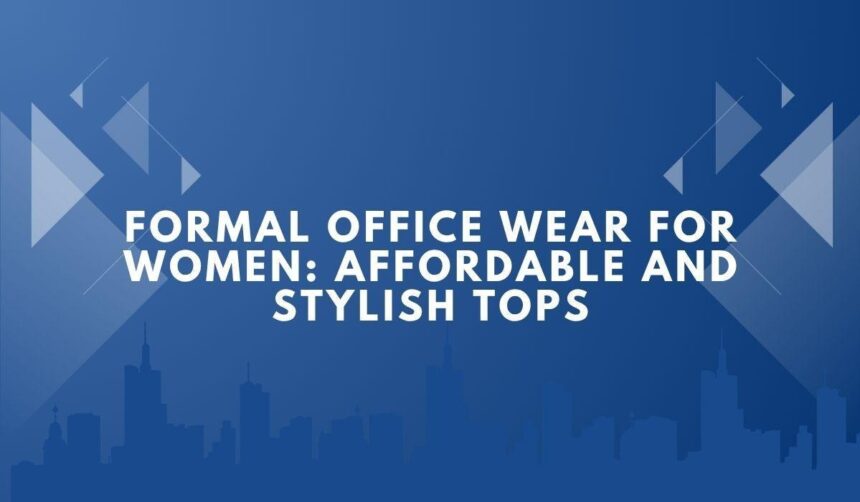Looking for formal office wear women – You got to read this full blog.
Office Dress Code Context
Most Indian workplaces expect neat, modest, and functional attire that supports long hours and mixed tasks. Tops that read formal on their own reduce reliance on heavy layering, especially in warmer regions. Policies vary by sector, so flexibility in styling helps maintain compliance without excess spending.
Fabrics for Indian Climate
Lightweight cotton, cotton blends, and rayon offer breathability for humid conditions while retaining structure. Polyester-rich blends reduce wrinkling and often come at lower price points than natural silks. In air‑conditioned offices, slightly heavier knits or twill weaves maintain shape through the day.
Silhouettes and Structure
Tailored shapes with gentle ease at the waist create a clean line without feeling restrictive. Subtle darts, princess seams, and paneling add structure that reads formal in meetings. Peplum, wrap-inspired, or straight-cut shells work across roles when the design stays minimal.
Necklines and Collars
Mandarin collars, classic shirt collars, and modest V-necks are commonly accepted in formal settings. Crew and boat necks suit conservative floors where coverage is preferred. The aim is simple geometry around the neckline to keep attention on overall neatness rather than ornament.
Sleeves and Coverage
Short sleeves, elbow sleeves, and three‑quarter sleeves balance comfort with formality across seasons. Full sleeves remain practical for highly air‑conditioned spaces or client‑facing roles. Minimal cuffs and clean hems reduce visual clutter and simplify laundering.
Colours and Patterns
Neutral tones—navy, charcoal, beige, cream, and muted pastels—pair easily with existing bottoms and reduce wardrobe costs. Micro‑checks, pinstripes, and small geometric repeats add interest without appearing casual. Loud prints are uncommon in conservative floors but may pass in creative teams if styling stays restrained.
Fit and Sizing Approach
Consistent sizing across vendors is rare, which leads to mismatched fits across shoulders and bust. Measuring key points—shoulder width, bust, and high hip—reduces returns and alternation expenses. Slight stretch content can improve mobility without compromising the formal line.
Construction Details That Matter
Interfacing at collars and plackets helps tops hold shape after multiple washes. Bias‑bound seams and reinforced hems increase lifespan in daily wear. Sturdy buttons and concealed plackets present clean fronts that sit well under blazers when required.
Layering and Versatility
Unlined tops with stable fabrics layer cleanly under lightweight blazers or cardigans. Neutral shells act as base pieces for rotation, lowering overall wardrobe spend. When external meetings arise, a simple jacket over a structured top meets stricter dress codes without a full outfit change.
Care and Maintenance
Machine‑washable blends lower upkeep costs and minimise downtime between wears. Dark colours benefit from gentle cycles and inside‑out washing to reduce fading. Steamers handle daily crease removal faster than full ironing, a small but practical time saver for weekday routines.
Budget Planning and Value
Cost efficiency often comes from a small capsule of interchangeable tops that pair with existing trousers and skirts. Simple designs avoid rapid trend fatigue and stay relevant across appraisal cycles. End‑of‑season assortments and multi‑buy packs commonly offer value without compromising core formality.
Seasonal and Regional Factors
Monsoon commuting favours quick‑dry fabrics that resist stains and moisture. Northern winters justify heavier knits or lined options for warmth inside older office buildings. Coastal metros lean towards breathable weaves with modest sleeves that balance sun exposure and indoor cooling.
Accessibility and Size Range
Size‑inclusive ranges now extend well beyond standard sets, improving fit for broader body types. Extended sizes with considered grading reduce shoulder pull and gaping at plackets. This shift lowers alteration costs and improves comfort in long, seated workdays.
Sector-Specific Nuance
Public sector offices and legacy enterprises often favour conservative colour palettes and classic collars. Funded startups and creative firms permit more relaxed patterns if the cut remains structured. Policy diversity means adaptable tops prevent wardrobe duplication across teams.
Practical Constraints and Trade‑offs
Wrinkle‑resistant fabrics save time but may feel warmer on crowded commute days. Fully natural fibres breathe well yet require more ironing and careful storage. For many professionals, the real trade‑off is speed of morning readiness against maintenance effort during the week.
Longevity and Rotation
A rotation of three to five formal tops covers most weekly schedules without accelerated wear. Replacing a single high‑use piece each quarter spreads costs predictably. Consistent fabric weights across the set help maintain a uniform appearance, even when mixing vendors.
Subtle Detailing, Formal Outcome
Minimal tucks, concealed buttons, and clean yokes add quiet polish that reads professional. Embroidery and ruffles, when present, are typically restrained and symmetrical. The result is a wardrobe that handles internal reviews, client calls, and desk work without frequent changes.
Fit Checks Before Purchase
Armhole comfort, shoulder alignment, and placket lay are frequent failure points in office tops. A quick movement test—reach forward, turn, sit—reveals pull or gaping issues early. Avoiding returns saves both time and transport costs across busy weeks.
Wardrobe Stability Over Trends
Formal office wear tops for women remains anchored in structure, clean lines, and repeatable pairings. Affordable choices come from practical fabrics, dependable fits, and limited but versatile colour sets. The outcome is a stable, professional wardrobe that functions across varied office environments without excess expense.


